Related Research Articles

Il Sodoma was the name given to the Italian Renaissance painter Giovanni Antonio Bazzi. Il Sodoma painted in a manner that superimposed the High Renaissance style of early 16th-century Rome onto the traditions of the provincial Sienese school; he spent the bulk of his professional life in Siena, with two periods in Rome.

Pinturicchio, or Pintoricchio, also known as Benetto di Biagio or Sordicchio, was an Italian Renaissance painter. He acquired his nickname because of his small stature and he used it to sign some of his artworks that were created during the fifteenth and sixteenth centuries.

The Chigi Chapel or Chapel of the Madonna of Loreto is the second chapel on the left-hand side of the nave in the Basilica of Santa Maria del Popolo in Rome. It is the only religious building of Raphael which has been preserved in its near original form. The chapel is a treasure trove of Italian Renaissance and Baroque art and is ranked among the most important monuments in the basilica.

Raffaellino del Garbo (1466–1527) was a Florentine painter of the early Renaissance.

The Parish Basilica of Santa Maria del Popolo is a titular church and a minor basilica in Rome run by the Augustinian order. It stands on the north side of Piazza del Popolo, one of the most famous squares in the city. The church is hemmed in between the Pincian Hill and Porta del Popolo, one of the gates in the Aurelian Wall as well as the starting point of Via Flaminia, the most important route from the north. Its location made the basilica the first church for the majority of travellers entering the city. The church contains works by several famous artists, such as Raphael, Gian Lorenzo Bernini, Caravaggio, Alessandro Algardi, Pinturicchio, Andrea Bregno, Guillaume de Marcillat and Donato Bramante.

The House of Chigi is an Italian princely family of Sienese origin descended from the counts of Ardenghesca, which possessed castles in the Maremma, southern Tuscany. Later, the family settled in Rome. The earliest authentic mention of them is in the 13th century, with one Alemanno, counsellor of the Republic of Siena.
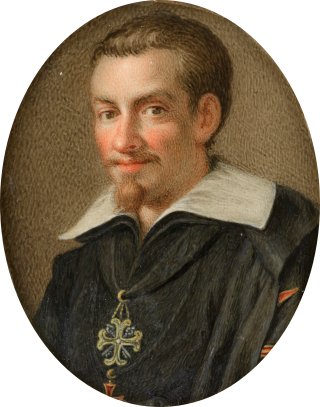
Francesco Vanni was an Italian painter, draughtsman, printmaker, publisher and printer active in Rome and his native city of Siena.

Agostino Andrea Chigi was an Italian banker and patron of the Renaissance.

Giacomo Boni was an Italian painter of the late-Baroque period, active mainly in Genoa.
Cesare Corte (1554–1613) was an Italian painter of the Renaissance period, active mainly in his natal city of Genoa.

Giuseppe Nicola Nasini was an Italian painter of the Baroque period and active in Rome and Tuscany.
Raffaello da Montelupo, born Raffaele Sinibaldi, was a sculptor and architect of the Italian Renaissance, and an apprentice of Michelangelo. He was the son of another Italian sculptor, Baccio da Montelupo. Both father and son are profiled in Vasari's Le Vite delle più eccellenti pittori, scultori, ed architettori.

Lorenzo di Lodovico di Guglielmo (1490–1541), known by the pseudonyms Lorenzo Lotti or Lorenzetto, was an Italian Renaissance sculptor and architect in the circle of Raphael.

Giovanni Maria Morandi was an Italian Baroque painter, known for altarpieces and portraits.
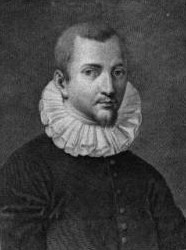
Rutilio di Lorenzo Manetti was an Italian painter of late-Mannerism or proto-Baroque, active mainly in Siena.

Astolfo Petrazzi (1583–1665) was an Italian painter of the Baroque period, active mainly in his hometown of Siena, but also Spoleto and Rome. He was a pupil of mainly Francesco Vanni, but also worked under Ventura Salimbeni and Pietro Sorri. He died in Siena.
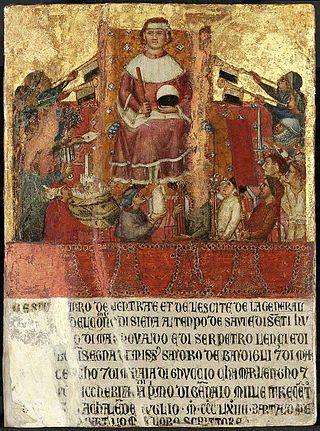
Lippo Vanni was a 14th-century Italian painter and miniaturist who was active in his native Siena.

Jacopo di Mino del Pellicciaio was an Italian painter, active in Siena.
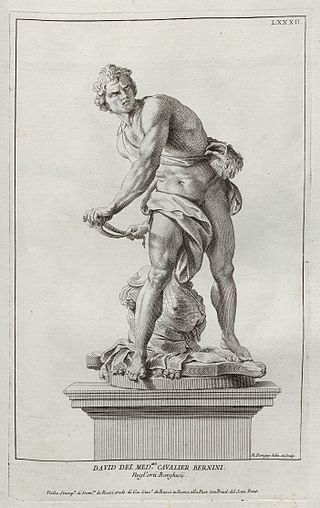
Sir Nicolas Dorigny was a French engraver, the youngest son of Michel Dorigny, and was born in Paris in 1652 or 1658. His education prepared him for the legal field, and he followed that profession until he was thirty years of age, when, as a result of deafness, he turned to the arts. He died in 1746.
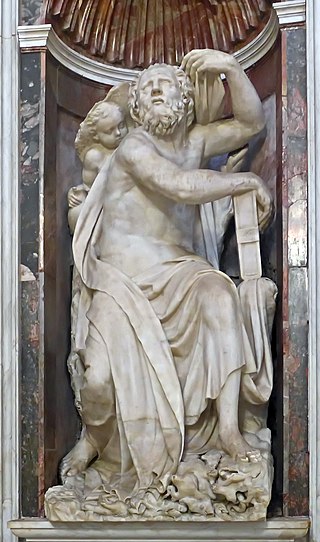
The statue of Elijah is a marble statue by the Italian Renaissance sculptor Lorenzetto in the niche to the right of the entrance in the Chigi Chapel, the Basilica of Santa Maria del Popolo, Rome. The sculptor followed the original designs of his mentor, Raphael, who was the architect of the chapel. The statue was finished by his pupil, Raffaello da Montelupo.
References
- ↑ Sabine Hoffmann (2021). "Vanni, Raffaello". Allgemeines Künstlerlexikon (in German). 112. Wikidata Q130457840.
- ↑ Christina Strunck: Bellori und Bernini rezipieren Raffael. Unbekannte Dokumente zur Cappella Chigi in Santa Maria del Popolo, Marburger Jahrbuch für Kunstwissenschaft 30. Bd. (2003), p. 149